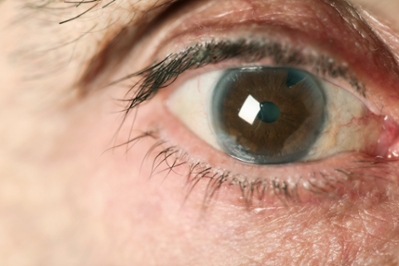Diabetes can increase your risk for eye and vision problems. This is because high blood sugar levels can damage blood vessels and nerves in the eyes.
If you are living with diabetes, taking good care of your eyes can reduce your risk for related vision problems.
What types of eye problems are related to diabetes?
Cataracts, glaucoma, and vision loss are some of the most common eye problems that affect people with diabetes.
Cataracts are cloudy areas in the lens of the eye. They can lead to blurry vision and change the way you see colors. If prescription eyeglasses cannot improve your vision, you may need surgery. Surgery may help restore your vision.
Glaucoma affects people aged 45 and older with diabetes. Glaucoma refers to a group of eye conditions that damage the optic nerve. When not treated, this condition may lead to vision loss or blindness. There are no treatments that can reverse glaucoma, but your doctor can work with you to slow its progression.
Diabetic retinopathy and macular degeneration are other eye problems related to diabetes. Diabetic retinopathy refers to damage to blood vessels in the eyes. Macular degeneration occurs when the part of the retina called the macula becomes damaged.
Being proactive with your eye health is a good way to reduce your risk for eye problems when you have diabetes.
Follow the following steps to avoid vision problems and vision loss.
Understand your risk for eye problems
Many people with diabetes do not know they are at high risk for eye problems. According to the Centre for Disease Control, 60% of people with diabetes do not get annual eye exams. Where there is no sound medicare access, people with diabetes are 25 times more likely to suffer blindness than people without diabetes. CDC also says that more than 90% of vision loss caused by diabetes may be prevented with early detection and treatment.
Understand that having diabetes increases your risk for eye problems. Your risk for eye diseases may be even higher if you meet other risk factors. For example, having high blood pressure, using corticosteroids, and being over the age of 60 can further increase your risk for glaucoma, reports the American Optometric Association.
See your eye doctor regularly
Meet with your eye doctor at least once a year for an eye exam. An eye doctor can often spot signs of eye diseases and vision loss early on. This can lead to early treatment and reduce your risk of vision loss and blindness.
Ask your general physician for a referral to an eye doctor who specializes in treating people with diabetes. An experienced eye doctor can perform a dilated comprehensive eye exam. This type of eye exam can screen for diabetes-related eye problems, including retinopathy, cataracts, and glaucoma.
During this exam, your eye doctor will examine the back of your eye to detect signs of these eye conditions. This can be done even if you’re not experiencing any symptoms and can lead to early treatment if necessary.
Manage your blood sugar
Many times, vision problems caused by diabetes occur due to poorly managed blood sugar. Therefore, managing your blood sugar is key to maintaining good eye health.
Eating at regular times, exercising regularly, and drinking plenty of water are some of the many steps you can take to manage your blood sugar. You should also take your diabetes medications as directed.
Meet with your doctor regularly if you have diabetes. Your doctor can perform the necessary tests to make sure your blood sugar level is within a healthy range. If it’s not, your doctor can work with you to bring it to a healthy range. This may reduce your risk of eye problems.
Manage your cholesterol
Over time, high cholesterol can damage your blood vessels. This can make it more likely for you to develop eye problems, especially if you also have diabetes.
Cholesterol can be checked with a routine blood test from your doctor. If your cholesterol is high, you can take medications to lower it or practice healthy behaviors that can lower it naturally. Eating healthy foods and staying active are some of the many effective ways to reduce high cholesterol.
Manage your blood pressure
High blood pressure can damage blood vessels throughout the body—including those in your eyes. This condition is common among people who have diabetes.
High blood pressure can often be effectively managed with medications. It can also be managed by practicing many of the same behaviors that can lower cholesterol. Exercising regularly, eating healthy foods, reducing stress, and getting quality sleep may help you reduce your blood pressure.
Eat healthy foods
When you have diabetes, eating nutritious foods can help you manage your blood sugar level and avoid spikes. Try to eat foods that contain nutrients that are great for your eye health. Beta carotene, vitamin C, and omega-3 fatty acids are some of the many nutrients that can reduce inflammation in the eyes. Vitamin E, zinc, and lutein are other nutrients that can help you avoid vision problems.
Beta carotene and vitamin C may help reduce oxidative stress in the eye. Oxidative stress can eventually damage the retina and worsen your vision. Beta carotene is present in orange-pigmented foods like carrots and sweet potatoes. Vitamin C is found in citrus fruits, tomatoes, and Brussels sprouts.
Zinc can help deliver vitamin A to the eye (beta carotene is converted to vitamin A in the body). Lutein is another orange pigment similar to beta-carotene. It can reduce your risk for glaucoma and macular degeneration.
Your doctor can work with you to develop a healthy meal plan that can benefit people with diabetes. Foods you should consider adding to your diet are leafy greens, carrots, broccoli, peanuts, chicken, and fish. Try to eat fatty fish, which contain the highest amounts of omega-3s. Salmon, tuna, mackerel, and sardines are examples of fatty fish.
Stay active
Exercise can help naturally balance your blood sugar. It can also improve blood flow and circulation, reduce stress, and lower high blood pressure and cholesterol. Many people with diabetes find that all their symptoms improve greatly after starting an exercise routine.
Talk to your doctor about the best exercises you can do based on your overall health status. Walking, swimming, cycling, and strength-training exercises are all excellent ways to stay active when you are living with diabetes.
Your doctor can also talk to you about when to check your blood sugar before and after workouts to ensure it’s within a healthy range. Generally, you should check your blood sugar every 30 minutes if you are doing a long workout or if you recently increased the intensity of your current workout. This can help you find out whether it’s safe to keep exercising.
Stop smoking
Smoking can damage your nerves and blood vessels. It can also increase your risk for heart disease, cancer, and other health problems, on top of vision problems. Cigarettes contain many damaging toxins and free radicals that can further affect your eye health.
Don’t start smoking if you are not a current smoker. If you feel that you are addicted to nicotine, ask your doctor for help with quitting. Your doctor may prescribe medications that can help you quit. Your doctor may also recommend the best form of nicotine replacement for you, such as gums, lozenges, or patches. Support groups are also available for those who need an extra source of encouragement when quitting smoking.
Wear sunglasses
The sun’s harmful UV rays can damage your eyes even when it’s cloudy outside. Going outdoors without sunglasses can increase your risk for cataracts and macular degeneration, even if you don’t have diabetes. Look for sunglasses that protect against both UVA and UVB rays, and wear them whenever you spend time outdoors.
When to see a doctor
Contact your doctor right away the moment you notice you have cloudy vision or any other changes in your sight. Eye pain, blurry vision, and flashes of light are examples of symptoms that indicate you should see a doctor.
Your doctor can perform an examination and suggest the best steps to take to care for your vision and prevent further damage. If you are diagnosed with a diabetes-related eye condition, your doctor can talk to you about all your available treatment options.


